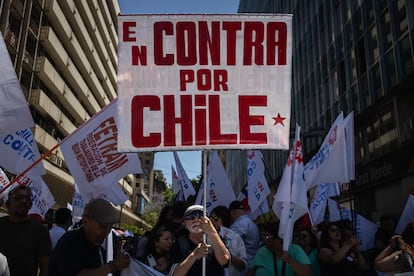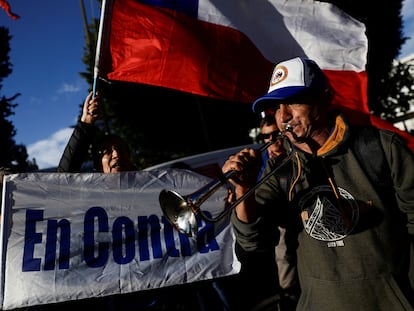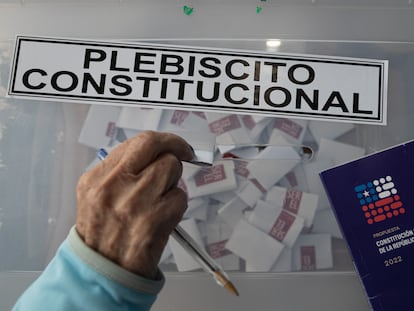What kind of Constitution did Chileans refuse to replace for the second time in four years?
The current charter was born in 1980, under the Pinochet dictatorship, but it has been amended 70 times since then. In 2022 the quorum required to modify it was lowered


Chile’s has been a long return back to square one, one that involved two constitutional processes in four years. In a second vote held this past Sunday, 55.76% of voters rejected the proposal for a new Constitution, compared to 44.24% who were in favor. The result means that the fundamental charter that was adopted in 1980 under the dictatorship of Augusto Pinochet — even though it has undergone 70 amendments since 1989, most of them in democracy — will remain in force.
Since 2005, this Constitution with 168 articles divided into 15 chapters has borne the signature of former socialist president Ricardo Lagos (2000-2006). “This is a very big day for Chile. We have reason to celebrate. Today we finally have a democratic Constitution, in line with the spirit of Chile,” said Lagos in August 2005, when 58 amendments were published in the Official Gazette. In that reform, several of the main authoritarian clauses that had kept much of the soul of the dictatorship alive were eliminated, including the designation of senators for life such as Pinochet himself, and the appointment of the armed forces as the guarantors of the nation’s institutions. Presidential terms of office were reduced from six to four years without immediate re-election, and greater oversight powers were given to the lower house of parliament, the Chamber of Deputies.
However, the welfare model implicit in the Constitution that contemplated social benefits, such as healthcare and pension checks, was maintained, with the participation of public agencies and special prominence given to private ones. The document does not integrate either the right to work (it only talks about freedom to work) or the right to housing. It alludes to women in a norm included in a 1999 reform stating that “men and women are equal before the law.”
In the current text, the Constitutional Court (TC) has the power to carry out preventive control of legislative bills, that is, to examine them before they are signed into law. It is a role that has been questioned, especially by the left, who have portrayed the court as a third legislative chamber. For example, in 2017 the judges declared unconstitutional some of the regulations that reformed the National Consumer Service (Sernac), including its ability to investigate, sanction and fine to suppliers who violate the law.
Despite all its reformulations over the last 30 years and the fact that Pinochet’s name has been removed from it, this is a Constitution that the left takes issue with because it was born in a dictatorship, which they see as its original sin. But at this second vote, paradoxically, they have voted to maintain it.

That original sin was one of the reasons, besides reinforcing social rights, why in November 2019, after the social unrest, the first constitutional process was promoted, although it turned out to be a failure when a constitutional commission dominated by the left presented a proposal that was rejected in a vote in 2022 by 62%.
After that fiasco, in 2023 the political class initiated a second process. This time, a constitutional commission in which the political right had a majority delivered a proposal that the left-wing governing party rejected. The latter campaigned to maintain the same fundamental charter that they had criticized for decades, arguing that the new project was even worse. According to one of the spokespersons for the “Against” campaign, Carolina Leitao, a Christian Democrat who is the mayor of Peñalolén, this proposal was “a Constitution 2.0 from the 1980s.”
But the desire to change the highest law in the land predates all of this. In 2018, at the end of her second term in office, former socialist president Michelle Bachelet (2006-2010 and 2014-2018) also attempted to replace the Constitution. The chosen method was not through constitutional commissions, but by sending a reform project to Congress that had no political backing from either the left or the right.
From unalterable to reformable
The Constitution that will remain in force in Chile was promulgated on October 21, 1980. Three commissions of lawyers appointed by the Military Junta, itself composed of four generals and led by Pinochet, had been working on the draft since 1976. It was put to the vote in a referendum in which there was no Election Qualifying Tribunal or Electoral Registry, so that the mayors appointed by the authoritarian regime fulfilled that role in the process. Then “yes” option won with 65.71% of the votes, a result that was questioned from the day one by the opposition.
The current Magna Carta has undergone three main reforms since then. “The three most important ones are those of 1989, which enabled the transition to democracy; those of 2005 [of the Lagos administration] and those that inaugurated the constituent processes of the current period,” the constitutionalist expert Gonzalo García, who was the coordinator of the reformulations promoted by former president Lagos, told El PAÍS.
Despite all the changes, it is a Constitution that was originally, and for many years, considered unalterable because it was very difficult to modify: it required a high quorum of two thirds of Congress.
But that changed in August 2022, a month before the September 4 plebiscite for the first constituent process. When it was already clear from the polls that the proposal would be rejected, a group of senators including Ximena Rincón, a former Christian Democrat and now a Democrat, promoted an amendment to reduce the required quorum to make reforms to the Magna Carta from 2/3 to 4/7, and this proposal was approved.
After this, notes Gonzalo García, the current constitution became a much more flexible text. In fact, says David Altam, a political scientist from the Catholic University, today changing Chile’s constitution requires one of the lowest quorums in Latin America: “You only need 4/7 of Congress. In the majority [of countries] it is 2/3.″
Sign up for our weekly newsletter to get more English-language news coverage from EL PAÍS USA Edition
Tu suscripción se está usando en otro dispositivo
¿Quieres añadir otro usuario a tu suscripción?
Si continúas leyendo en este dispositivo, no se podrá leer en el otro.
FlechaTu suscripción se está usando en otro dispositivo y solo puedes acceder a EL PAÍS desde un dispositivo a la vez.
Si quieres compartir tu cuenta, cambia tu suscripción a la modalidad Premium, así podrás añadir otro usuario. Cada uno accederá con su propia cuenta de email, lo que os permitirá personalizar vuestra experiencia en EL PAÍS.
¿Tienes una suscripción de empresa? Accede aquí para contratar más cuentas.
En el caso de no saber quién está usando tu cuenta, te recomendamos cambiar tu contraseña aquí.
Si decides continuar compartiendo tu cuenta, este mensaje se mostrará en tu dispositivo y en el de la otra persona que está usando tu cuenta de forma indefinida, afectando a tu experiencia de lectura. Puedes consultar aquí los términos y condiciones de la suscripción digital.
More information
Archived In
Últimas noticias
NASA discovers Titan doesn’t have an ocean, but a ‘slushy ice layer’ that increases possibility of life
Innocence lost in the forest of the child soldiers: ‘Each leader of the armed group had his girls’
‘Fallout’ or how the world’s largest company turned an anti-capitalist apocalyptic Western into a phenomenon
From inflation to defending migrants: Eileen Higgins and Zohran Mamdani inaugurate the new Democratic resistance against Trump
Most viewed
- Christian Louboutin: ‘Young people don’t want to be like their parents. And if their parents wear sneakers, they’re going to look for something else’
- ‘El Limones’ and the growing union disguise of Mexican organized crime
- The low-cost creative revolution: How technology is making art accessible to everyone
- ‘We are dying’: Cuba sinks into a health crisis amid medicine shortages and misdiagnosis
- Liset Menéndez de la Prida, neuroscientist: ‘It’s not normal to constantly seek pleasure; it’s important to be bored, to be calm’










































